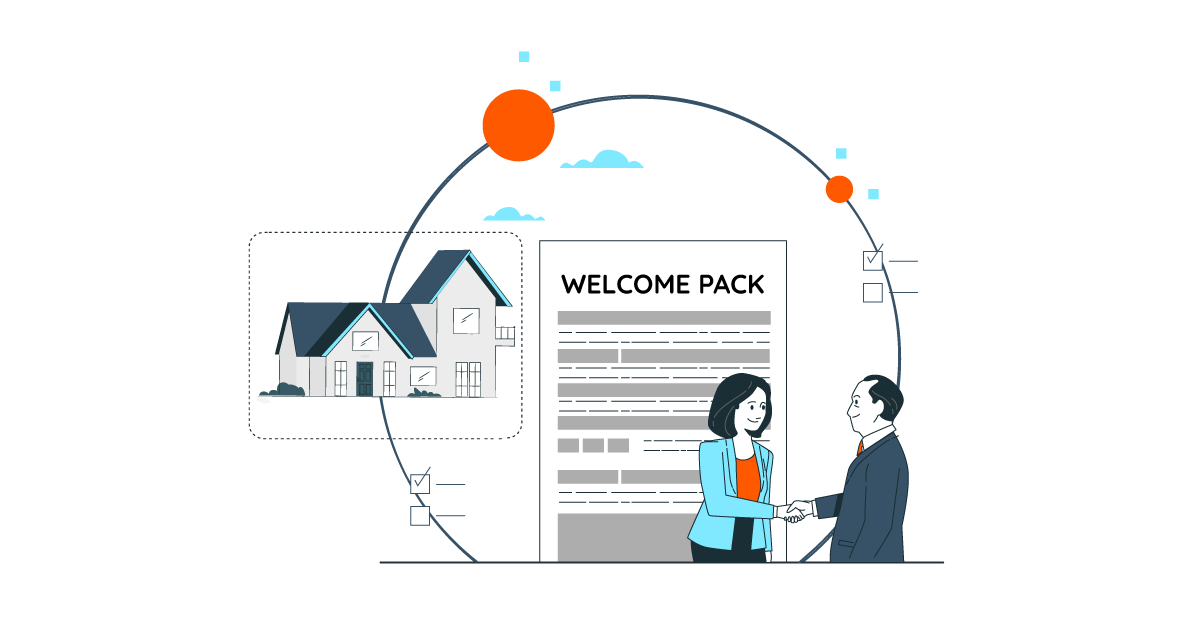
|
Highlights:
|
A landlord’s tenants are their customers, and so fostering a good relationship with them is critical.
Welcome packs are a great way to do this and can set the tone for the rest of the tenancy.
But according to research from Hamilton Fraser, one-third of landlords don’t provide a welcome pack.
These landlords are missing out on a number of benefits. This article explains what a welcome pack is, what benefits they provide and what you could include in yours. We’ll also provide some general tips on how to be a good landlord.
What Is a Welcome Pack?
A welcome pack is a convenient way to provide your residents with all of the information they need to live at one of your rental properties.
It might include:
-
A copy of the tenancy agreement
-
Safety certificates
-
Administrative information
-
Information about the property
-
Tips on how to look after the property
-
Information on the local area
-
A card and/or gift
Why Provide a Welcome Pack?
The biggest reason to provide a welcome pack is that it gets the landlord-tenant relationship off to a great start.
Making a good first impression helps your new tenants feel welcome, encourages them to communicate with you and makes them longer-lasting tenants.
Other reasons to provide welcome packs include:
✔️ Makes you look professional
✔️ Helps ensure that the tenant has all documents they require by law
✔️ It’s convenient for them to have all tenancy information in one place
✔️ Helps tenants look after the property
✔️ Tenants are more likely to report problems
✔️ It’s an opportunity to clarify grey areas, like who maintains the garden
Ultimately, welcome packs mean happier tenants, which saves you time, stress and money.
What Should Your Welcome Pack Include?
Your tenancy pack can include whatever you think is relevant to your new tenants. However, there are a few documents that you must give your tenants by law, which you can include in the welcome pack.
This includes:
A copy of the tenancy agreement
Your tenant should have already signed a tenancy agreement and you are required to provide them with a copy.
This guide to tenancy agreements from the National Residential Landlords Association (NRLA) provides detailed information on tenancy agreements and what they should include.
Your contact details
By law, you need to provide your tenant with your full name and address. But if you want to have a transparent relationship then it’s also a good idea to provide your full contact details. If you don’t intend to deal with maintenance issues or collect rent yourself then make sure that’s clear and give them details of who to contact instead.
Gas safety certificate
Otherwise known as a gas safety record. You need to get a registered gas engineer to check all appliances and fittings in the property once per year.
The engineer will give you a gas safety certificate and you need to provide a copy of this to your tenant.
Energy Performance Certificate (EPC)
You must provide a copy of your property’s EPC certificate at the beginning of each new tenancy. If you don’t have one then you need to contact a domestic energy assessor. They will perform an energy assessment survey and provide a certificate that grades your property’s energy efficiency from A (most efficient) to G (least efficient). This certificate lasts 10 years. To be able to rent out a property the EPC score must be an E, until 2025 when it must be a C.
Deposit protection certificate
If your tenant has paid a deposit then you should be signed up to one of the government’s approved deposit protection schemes. The scheme will provide you with a certificate which you need to sign and give to the tenant. It’s also helpful to tell them where they can find more information about the scheme.
How to Rent guide
The How to Rent guide is an online government document providing advice to current and prospective tenants on the rental process in England and Wales. You have to provide each new tenant with a copy of the guide. If you don’t then they can successfully challenge any future eviction attempt.
What Other Information Should You Include?
The items in this section aren’t required by law, but they’re still either important for you or useful for your new tenants.
Inventory
An inventory is a detailed list of the property including its contents and fixtures. It also details the condition of each item and provides dated photographic evidence.
Both you and the tenant should sign the inventory before the tenancy begins.
The point of an inventory is to record the condition of the property and confirm that everything is still in good condition when the tenancy ends. If it isn’t and funds need to be deducted from the tenant's deposit, then the photographic evidence helps avoid disputes.
Utilities information
Provide new tenants with the following information:
-
Who supplies their gas, electricity and water, which plans they are on and how they can get in touch with the suppliers.
-
The location of things like gas and electricity meters, as well as stop cocks and fuse boxes.
-
Who to call if there is an emergency involving one of the utilities.
You should also ask your tenant to take a meter reading on all relevant utilities.
Appliance information
Provide manuals for any white goods and other utilities and tell the tenants who to contact for repairs.
Property upkeep tips
As a landlord, looking after your rental properties is second nature. But this may not be the case for your new tenants. This may be especially true if you have younger tenants and this is the first time that they have been responsible for a home.
By providing guidance on how to look after different aspects of your property you:
-
Help them maintain a pleasant home environment
-
Set upkeep expectations
-
Protect them from hazards
-
Keep your property in good shape
Here are some of the things that you should cover:
Damp and condensation prevention
These issues can seriously damage your property. Remind tenants to leave heating on at a minimum level and provide advice on keeping the property ventilated.
Tell them to report any leaking taps or pipes immediately. Explain how this can turn into damp or mould and the damage this could do to their home.
Gardening
Explain your expectations regarding the garden’s upkeep and provide your tenant with tips on how to fulfil them. Tell them where to find gardening tools and explain how to cut the grass, trim hedges and any other information they might need.
Security
Make sure your tenants understand how to use any locks and alarms that you have installed. Provide them with some basic tips on how to avoid becoming a victim of crime.
It’s also worth reminding them that it is up to them to buy contents insurance to protect their possessions.
Fire safety
Your rental property must follow certain fire safety regulations. Explain what these are and provide tenants with fire safety tips.
Explain that you have fitted smoke alarms and carbon monoxide detectors and ask them to test them once per month.
What to do if they want to end their tenancy
Explain what your tenant’s rights are with regards to ending their tenancy. This ensures that there are no disputes or frustrations when your tenant wishes to move out.
Here is a useful guide from Citizens Advice explaining how tenants can end their tenancy.
How to give feedback
You don’t have to do this, but asking for feedback from tenants ensures their voice is heard. It also gives you valuable information to help improve your business.
Information about the area
If your tenants are new to the area, it can improve their tenant experience if you point them towards some local amenities.
This could include local:
-
Leisure facilities
-
Places to eat
-
Where to shop
-
Doctors’ and dentists’ surgeries
-
Hospitals and police stations
-
Post offices
-
Information about the council
-
When are bins collected
-
Local recycling facilities
Gifts and a card
This is another nice-to-have. Moving into a new home is a big moment for your tenant, so it’s nice to wish them well in their new home. A card and perhaps a small gift like some chocolates is a simple but effective way to get the relationship off to a great start.
How to Create a Welcome Pack
Once you have gathered all of this information, it’s up to you how much effort you put into presenting it.
There are three main routes:
Basic Approach
You can simply use your business’s letterhead or a template in a Microsoft Word document and list all of the information.
This can then either be printed out or emailed to the tenant. This is a low-cost approach, but it doesn’t look very professional.
Hamilton Fraser provides a good tenant welcome pack template that you can use.
Design a Brochure
You can use a pre-existing template or design package to create a brochure. Better yet, you could employ a graphic designer to do it for you.
This will look much more professional but will cost you more time and money.
Here’s a good example of a tenant welcome pack brochure from letting agents Smart Property. It looks great and is very detailed.
Something like this could be given to the tenant in a ring binder, along with other documents like the tenancy agreement and gas safety certificate.
Use a Digital Platform
Tenancy management platforms allow tenants to access all the documentation and information they need. This looks professional and is convenient for tenants and landlords.
EVO’s Living App is a great example of this. It saves costs as you don’t have to print new tenancy welcome packs, plus renewed certificates and updated documents can be automatically uploaded to the tenant’s app. The app allows tenants to report issues and improves overall communication.
Top Tips on How to Be a Good Landlord
This section provides tips on how to be a good landlord and offer the best possible tenant experience.
Treat tenants like customers
Do what you can to ensure that your tenants have a good experience with your property, and be polite and professional at all times. At the same time, set boundaries as to what is acceptable behaviour and explain to tenants what happens if they cross these boundaries.
Don’t skimp on safety
Make sure you go over and above all safety standards that you are obligated to meet. Use a checklist to make sure that all checks are performed and any remedial action work is completed quickly. Record these activities and make the evidence available to your tenants.
Carry out regular property inspections
Inspect your property on a regular basis (every six months). This ensures that any problems are dealt with before they become a bigger issue, providing your tenant with a safe and pleasant home environment.
If you rarely find issues at a property and the tenant is good at reporting problems, consider reducing the frequency of inspections.
Create a personalised tenancy agreement
It’s a good idea to adjust the tenancy agreement to suit the individual tenant and property. It makes the agreement more succinct and makes each party’s responsibilities clearer. However, you should seek legal advice before doing this.
Be flexible
It’s a good idea to have set processes. But you should also be prepared to deviate from them if it suits your tenant. For example, you could be flexible on rent payments - this can help them manage their finances better and ensures that you get your rent. If tenants are struggling with rent payments or anything else related to their tenancy, be empathetic and negotiate a solution.
Another option is to consider zero-deposit tenancies. This where your tenant doesn’t pay a deposit and instead buys a cheaper insurance policy. This opens your rental property up to a wider range of potential tenants, with no additional risk.
Be approachable
This helps to ensure that tenants report maintenance issues to you or discuss rent problems early. Make sure you are always contactable during the day and be polite and helpful whenever your tenant calls. If their request is inconvenient or unreasonable then explain that patiently and try to find a solution.
Communicate well
When a tenant does approach you with a problem you must take it seriously. If you can’t deal with the issue immediately then let them know what your plan is and stay in touch with them to report progress.
Provide multiple contacts
Make sure you appoint a trusted person that your tenants can contact if you are not available. This could be an employee, a family member, or even a trusted tradesperson. This is particularly important when you go on holiday but needs to be in place all year round. For example, if there is an emergency and you cannot answer the phone then your tenant needs to be able to contact someone.
Respect tenant privacy
Your tenants have a right to privacy. You should only communicate with them when you have to. You need to give at least 24 hours’ notice before you visit the property, but try to give them at least a week’s notice. It is illegal to drop round unannounced.
Store documents in the cloud
Landlords are responsible for huge amounts of admin and paperwork. Losing important documents can be inconvenient for you and your tenants. Plus it can cost you money,for example, if you need to claim tax back maintenance costs but can’t find invoices and receipts.
A good way to avoid this problem is to use a platform like EVO to manage tenants and contractors. You can access all important documents relating to all aspects of your property, saving you time and reducing the risk of losing critical paperwork.
Improve Your Tenant Experience Today
In this article we explained how to improve the tenant experience by providing welcome packs. We also listed some top tips for being a better landlord.
If you want to find out more, check out our article on the tenant experience and why it matters or sign up with EVO today.
PHOTO BY EVO


